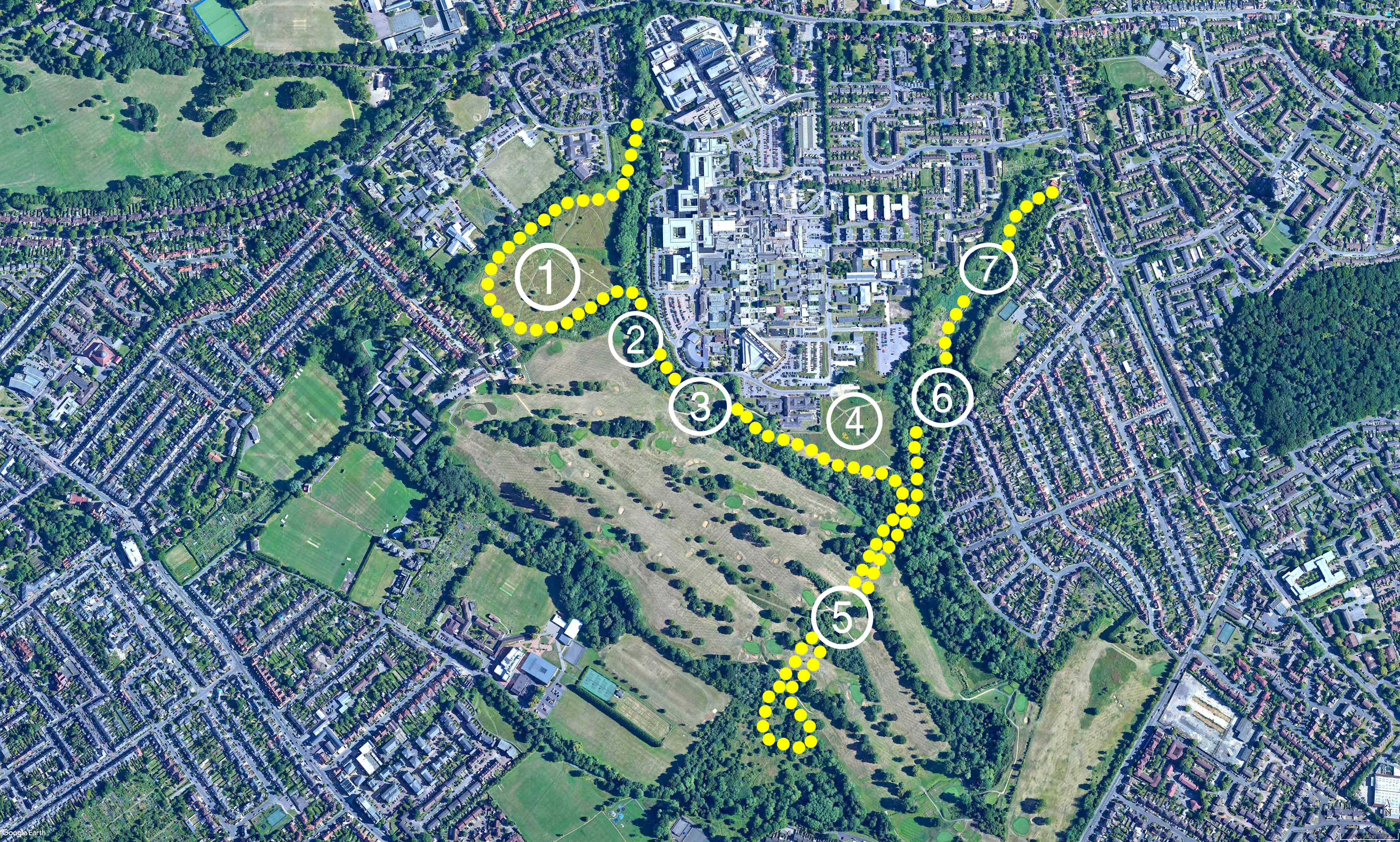I have missed not having a local patch. Having spent eight years tramping around the fields of Cuddesdon, I really wanted a good nearby waterbody that would attract a wider selection of species, compared to farmland. I experimented with visiting some well known local sites, for example Farmoor and Otmoor, but found them either too well covered, or too large to cover in my limited avilable time. I also explored smaller water bodies further afield, but quickly realised that I needed a patch that was within walking distance of my house.
So, over the last three months I have regularly visited a “Y”-shaped piece of land around the nearby Churchill Hospital in Headington, Oxford:
The habitat is varied, but is crammed into East Oxford, between the hospital and housing estates. It does have the advantage of being on top of a hill and has an adjoining golf course, whose open areas I still dream may attract passing migrants. The star of the show is the Lye Valley Nature Reserve. This remarkable piece of wet fenland is centuries old and is home to an incredible range of plants. These survive mainly thanks to the work done by the Friends of Lye Valley and their working parties, led by Dr Judy Webb.
My usual route begins just off Old Road, Headington. I follow the Boundary Brook stream through the narrow strip of mature trees that survive between the new housing estate of Little Oxford and the University’s Old Road campus. The larger lime trees (I think) have many old woodpecker holes and are home to breeding Jackdaw, Stock Dove and Nuthatch: 
As the stream passes the Churchill Hospital, there is a small balancing pond. This holds water draining from the hospital site, before it enters the Boundary Brook. The fantasy here: Water Rail. The reality: Moorhen. 
I then do a circuit of Warneford Meadow, [1] on the map above. This open area, right on top of the hill, has scattered trees and nice shrubby hedgerows:
 The fantasy here: Redstart. The reality: Meadow Pipit.
The fantasy here: Redstart. The reality: Meadow Pipit.
I rejoin the Boundary Brook stream and work my way between the hospital and the golf course [2]. The small valley here is filled with alders: The fantasy here: Mealy Redpoll. The reality: Siskin.
The fantasy here: Mealy Redpoll. The reality: Siskin.
Following this small valley south-east, one emerges on the hospital road to find what looks like the world’s largest mist net [3]. This is in fact a screen to protect the hospital from golf balls being aimed at the 18th green, in the foreground:
The Boundary Brook valley then runs alongside a small meadow at the south end of the hospital [4]:  There are reeds on the edge of the meadow, which contains some strange man-made mounds. I have met hospital workers who remember that there were Nissen Huts here, left over from when this was an American base in the Second World War. Frighteningly, some were still used by the hospital for appointments, at least until the 1990s. The fantasy here: Black Redstart. The reality: Robin.
There are reeds on the edge of the meadow, which contains some strange man-made mounds. I have met hospital workers who remember that there were Nissen Huts here, left over from when this was an American base in the Second World War. Frighteningly, some were still used by the hospital for appointments, at least until the 1990s. The fantasy here: Black Redstart. The reality: Robin.
I then head south, through the woods at the bottom of the Lye Valley and cross Southfield Golf Course [5]. I like the idea of birding the golf course, which is right on top of the ridge, with open grassy areas and scrubby patches. But there are a number of issues. Firstly, there is the possibility of being hit by golf balls:
Secondly, you may be suddenly doused by the watering system on the greens. Without warning sprinklers are turned on, which does not always make for relaxed birding:  The fantasy here: Hoopoe. The reality: Pheasant.
The fantasy here: Hoopoe. The reality: Pheasant.
The furthest south I get is the scrub on the slope of the hill between the golf course and the Barracks Lane cycle track:  The fantasy here: Nightingale. The reality: Blackcap. I do a circuit here, then retrace my steps back over the golf course to return to the Lye Valley proper [6]:
The fantasy here: Nightingale. The reality: Blackcap. I do a circuit here, then retrace my steps back over the golf course to return to the Lye Valley proper [6]:  Emerging from the woods, one finds small pools by the boardwalk at the bottom of the fen. From the top of the reserve [7] the stirling work done by volunteers to keep the fen free from encroachment by trees and shrubs can be seen:
Emerging from the woods, one finds small pools by the boardwalk at the bottom of the fen. From the top of the reserve [7] the stirling work done by volunteers to keep the fen free from encroachment by trees and shrubs can be seen: 
This spring I have really enjoyed my early morning birding in these narrow green corridors, between the hospital, the golf course and the houses. Coming soon: a summary of the birds seen here this spring: March, April and May 2019.
